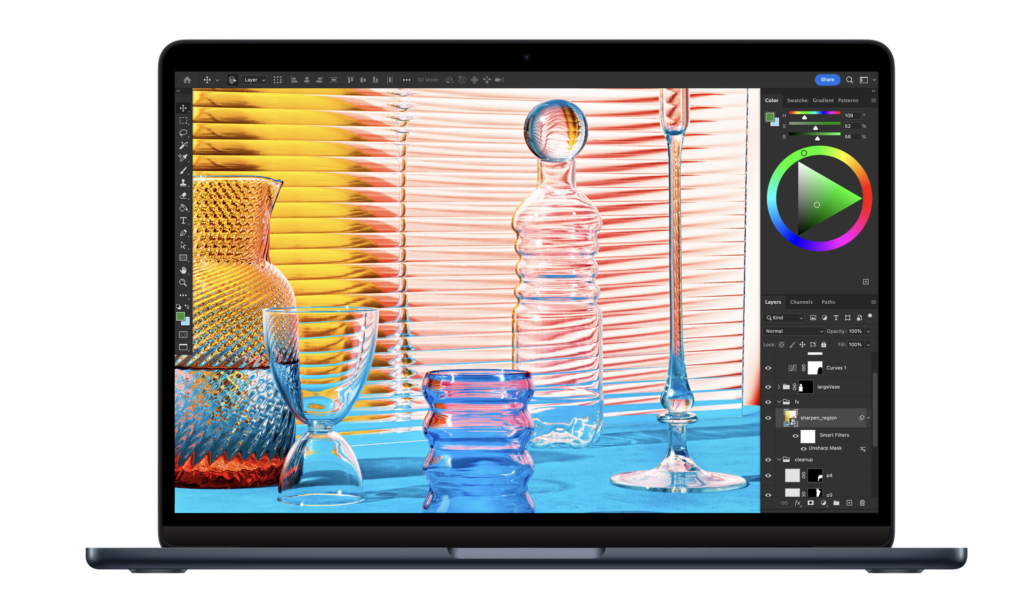
So we’re hearing increasing rumors that Apple will open up pre-orders on the new M2 MacBook Air later this week. (Specifically, Friday morning.) My interest in this computer is more than just academic. Currently, I have my beloved MacBook Pro, which is the backbone of my business. That said, it is expensive, big, and heavy. When I leave the house for an afternoon (or for a week), I’m always hesitant to bring it along. Even around the house, this isn’t a computer that is particularly easy to use while laid up in bed for a few days or even on the couch.
I want a second computer that I can use on the go. And by “computer”, I mean a Mac that can run all of my nerdy tools like Keyboard Maestro and AppleScript without limitation.
I have to admit that an additional attraction for me with the M2 MacBook Air is that I first held one at Apple Park in the Steve Jobs theater. That gives the computer a certain built-in sentimentality for me.
So I’ve gone through the Apple Build-to-order specs for the new M2 MacBook Air, and I’ve got thoughts.
The Standard Builds
The two offered MacBook Air builds are similar. Let’s look at the viability of those two machines first. The differences are:
Price: $1,199 vs. $1,399
GPU Cores: 8 vs. 10
SSD: 256GB vs. 512GB
Power Supply: Single 30W vs. Dual 35W
GPU Cores
Graphics cores are swell, not just with games but with video work, renders, and many other processes on your Mac. It is important to note that the MacBook Air is not Apple’s graphics powerhouse. (Some MacBook Pro Builds have 32 Cores, and there is a Mac Studio build with 64.) Most people looking to buy a MacBook Air are not looking for extreme graphics performance, and eight or ten cores will feel about the same.
SSD
There was a time when the built-in storage of your Mac was only temporary, and you could always upgrade later. That isn’t true anymore. In my opinion, 256GB is barely viable. Unless you have meager data needs and are willing to keep your Photos library in the cloud, it’s not enough. While most people could get by just fine with an 8-core GPU, I think very few people will be ultimately happy with a 256GB SSD, particularly if they intend to hold onto the computer for any time. I believe future you will thank you for upgrading the SSD to 512 GB.
The Power Supply
The dual power supply of the upgraded power supply is nice but hardly a must-have. Anker sells a dual 40W charger that you can order today.
So Which Standard Build?
If you are just looking to get a standard build, the ones in the stores and that ship the fastest, I would (not surprisingly) recommend the $1,499 starting build. That is primarily for the increased SSD storage. The 256GB SSD is the reason I can’t recommend the lower-tier standard build.
That said, I don’t think either standard build is something I’d recommend for a power user. That’s primarily because of the RAM Problem.
The RAM Problem
Both of Apple’s standard builds come with 8GB of RAM, which feels a lot to me like the 256GB SSD. 8GB can work, but if you do more than word processing and non-Chrome browsing, you will feel the lack of RAM. Since the M1 release, I’ve heard from multiple listeners and readers that have had low RAM issues (and regrets) on their 8GB M1 MacBook Air machines. Modern apps use a lot of memory, and 8GB is not much to go around. When you run out of memory, your Mac sends “memory” bits to your SSD, noticeably slowing things down. Unlike the 8 vs. 10 graphics cores, you’ll notice when your Mac starts using your SSD as RAM.
I recommend upping the RAM to 16 GB for $200. For $400, you can increase it to 24GB. I’d default to 16GB and only go up to 24GB for a good reason.
Storage
As I explained earlier, I think an upgrade to 512GB is nearly mandatory. Above that is up to you. I know people who prefer to keep all storage on board, and for them paying Apple prices for additional storage is worth it. I know others are happy to carry around a less expensive (and slower) external drive and a cable for extra storage. So to me, the floor here is 512GB. Above that is your call.
Looking At Choke Points
Underlying all this advice is my belief that these Apple Silicon Macs will run for a long time. iPads seem to run these days forever, and this MacBook Air is similar to an iPad on the inside.
So going three to five years into the future, the problems you’ll face with these machines will not be the processor quitting but instead the constraints of storage and RAM. Investing in these choke points now gives the machine a longer life.
Colors
I have made no mystery that I’m not a fan of the M2 MacBook Air color offerings. After releasing those colorful iMacs last year, I’ll never understand why they didn’t do the same for the MacBook Air this year.
I expect the Midnight color will be the most popular, but it isn’t exactly black, and it isn’t exactly dark blue. I don’t love any of these colors. My intention is get the Silver one and, for the first time in my life, I’m looking very seriously at the dbrand skins.
